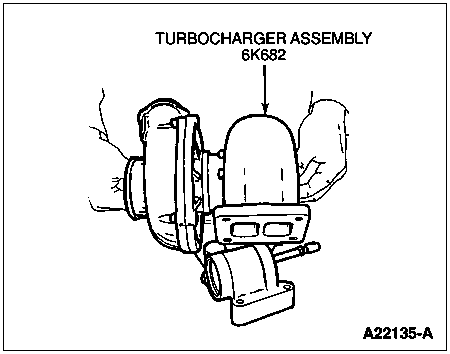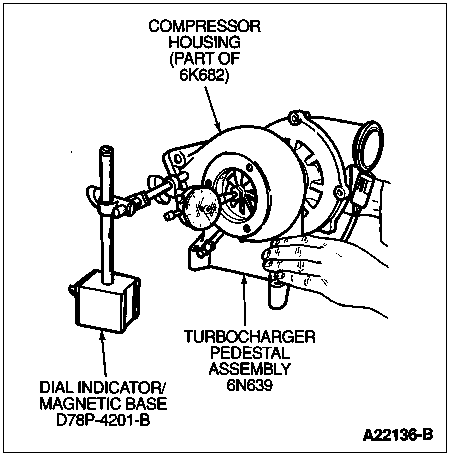Wheels must spin freely when turned by hand. No housing contact is permitted.

Section 03-04E: Turbocharger, 7.3L Diesel Engine | 1996 F-250, F-350 and F-Super Duty Workshop Manual |
Turbocharger Leak Tests
Check for loose connections or damage to the air intake hose and air intake tube. Any debris entering the intake side of the turbocharger can damage compressor blades, causing an imbalance resulting in bearing failure.
Air leaks at the compressor manifold, intake manifold hoses or intake manifold covers could cause excessive smoke and a loss of engine power, as well as a noise problem. Visually inspect components for loose connections or damage. Apply liquid soap to compressor manifold and air intake manifold hose connections and intake manifold cover sealing surfaces to assist in detecting any air leakage. Any bubbles created will indicate the source of the leak.
Inspect for exhaust leaks at the exhaust manifold (9430) and turbocharger, gasket leaks, or exhaust pipe restrictions. Leaks or restrictions will cause the turbine and impeller to operate at a lower speed and reduce the amount of air being forced into the cylinders. Again, the symptom will be excessive smoke, low manifold pressure and low power.
Exhaust leaks can usually be detected audibly or visually by a discoloration caused by the escaping hot gases.
Bearing Clearance Check
When there is reason to suspect that the turbocharger bearings are worn to the extent that the compressor or turbine wheel rubs the housing, perform the following procedures.
Check for Free Rotation
Stand turbocharger on a bench with shaft in a horizontal position.
Wheels must spin freely when turned by hand. No housing contact is permitted.

Manually move the turbocharger blade shaft assembly as far in one direction as possible. Spin the shaft by hand.
Manually move the shaft in the opposite direction as far as possible, and spin the shaft again.
If neither the turbine band nor the compressor blade contacts any portion of their respective housings, the bearings are still good.
If either blade comes in contact with the housing, the bearings are worn, and the turbocharger should be replaced.
Check Axial End Play
NOTE: Radial shaft movement cannot readily be measured on this turbocharger.
With turbocharger in a stable position, place tip of Dial Indicator/Magnetic Base D78P-4201-B or equivalent on turbine end of shaft and zero the indicator.
Move shaft back and forth by hand and record reading.
If reading exceeds specifications, turbocharger must be reconditioned or replaced. Refer to Specifications in this section for dimensions.
